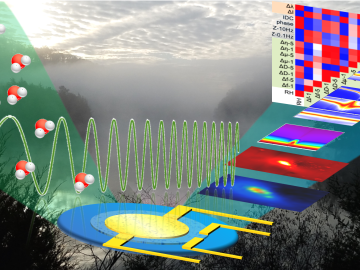
Filter News
Area of Research
- (-) Biological Systems (2)
- (-) Materials (47)
- Advanced Manufacturing (6)
- Biology and Environment (74)
- Computational Biology (2)
- Computer Science (2)
- Electricity and Smart Grid (2)
- Energy Science (61)
- Fusion and Fission (2)
- Fusion Energy (2)
- Isotopes (3)
- Materials for Computing (12)
- National Security (10)
- Neutron Science (18)
- Nuclear Science and Technology (4)
- Quantum information Science (3)
- Sensors and Controls (1)
- Supercomputing (35)
News Type
News Topics
- (-) Bioenergy (5)
- (-) Grid (2)
- (-) Materials (31)
- (-) Molten Salt (1)
- (-) Nanotechnology (16)
- 3-D Printing/Advanced Manufacturing (10)
- Advanced Reactors (2)
- Artificial Intelligence (4)
- Big Data (2)
- Biomedical (5)
- Buildings (2)
- Chemical Sciences (11)
- Clean Water (3)
- Composites (6)
- Computer Science (9)
- Coronavirus (2)
- Critical Materials (5)
- Cybersecurity (1)
- Energy Storage (13)
- Environment (7)
- Exascale Computing (1)
- Fusion (4)
- High-Performance Computing (1)
- Isotopes (8)
- Machine Learning (2)
- Materials Science (36)
- Mathematics (1)
- Microscopy (12)
- Neutron Science (13)
- Nuclear Energy (12)
- Partnerships (3)
- Physics (12)
- Polymers (10)
- Quantum Computing (2)
- Quantum Science (1)
- Security (1)
- Space Exploration (2)
- Summit (1)
- Transportation (10)
Media Contacts

Researchers at Oak Ridge National Laboratory and Korea’s Sungkyunkwan University are using advanced microscopy to nanoengineer promising materials for computing and electronics in a beyond-Moore era.

A study led by researchers at ORNL could help make materials design as customizable as point-and-click.

Neuromorphic devices — which emulate the decision-making processes of the human brain — show great promise for solving pressing scientific problems, but building physical systems to realize this potential presents researchers with a significant

A multidisciplinary team of scientists at ORNL has applied a laser-interference structuring, or LIS, technique that makes significant strides toward eliminating the need for hazardous chemicals in corrosion protection for vehicles.

At the Department of Energy’s Oak Ridge National Laboratory, scientists use artificial intelligence, or AI, to accelerate the discovery and development of materials for energy and information technologies.

On Feb. 18, the world will be watching as NASA’s Perseverance rover makes its final descent into Jezero Crater on the surface of Mars. Mars 2020 is the first NASA mission that uses plutonium-238 produced at the Department of Energy’s Oak Ridge National Laboratory.

Systems biologist Paul Abraham uses his fascination with proteins, the molecular machines of nature, to explore new ways to engineer more productive ecosystems and hardier bioenergy crops.

An all-in-one experimental platform developed at Oak Ridge National Laboratory’s Center for Nanophase Materials Sciences accelerates research on promising materials for future technologies.

From materials science and earth system modeling to quantum information science and cybersecurity, experts in many fields run simulations and conduct experiments to collect the abundance of data necessary for scientific progress.

Liam Collins was drawn to study physics to understand “hidden things” and honed his expertise in microscopy so that he could bring them to light.


